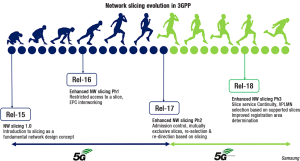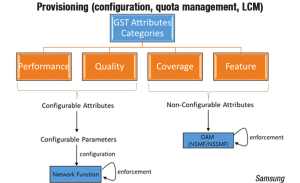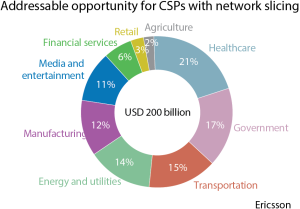5G Features
Network slicing –The killer app for 5G

5G network slicing is emerging as a silver bullet for allowing operators to create service instances quickly and flexibly, enabling different services to have their logical slice instances on a shared infrastructure.
As 5G networks roll out, telcos have a golden opportunity to generate substantial amounts of revenue. To do this, they will need to leverage network slicing as effectively and efficiently as they can.
The network slice enables the 5G service, it is a subset of the network functions, and can be instantiated and removed via SDN-based network management functions. The result is that operators can manage the network slice as a logical network function deployable for any network type and client. Global mobile operators and their corporate customers will witness a quantum jump in mobile network connectivity, quality of service, and revenue creation as 5G network slicing advances.
The global network slicing market, is anticipated to exhibit a CAGR of 25.4 percent during the period, 2022–2026, eclipsing USD 20 billion by 2026. In order to get the biggest chunk of that pie, CSPs will need to simplify their tech stacks and ensure that they are able to act on data as quickly as possible.
It will be 2023 until there is general commercial availability of 5G network slicing, says IDC. The exception is China, which is expected to have some commercial offerings in 2022 as it has the most mature 5G market. Even then, it will take until 2025 before global revenues from slicing exceeds a billion US dollars. In 2026, IDC forecasts slicing revenues will be approximately USD 3.2 billion. However, over 80 percent of those revenues will come out of China.
3GPP, defines five key functions/domains within the 5G network slice management model and each of these functions has highly specialized requirements:
- Communication service management function (CSMF) translates a service request into network slice requirements;
- Network slice management function (NSMF) coordinates the creation and management of network slices across the subnets (domains); and
- Three types of network slice subnet management functions (NSSMF) RAN, 5G Core, and transport network all manage their respective slice components.
Evolution of slicing in 3GPP standards. APN (access point name) was probably the earliest form of network slicing in a mobile network, which allowed operators to divide their networks according to service requirements. Each distinct service could be identified by a separate APN-name, and users would connect to their compartment (APN) depending on the service they wanted to consume. This form of slicing, however, required common network functions’ (NFs) resources shared among multiple APNs, and thus services were not fully isolated.
The 5G network architecture of 3GPP Release-15 was a great leap forward, where network slicing became fundamental to network design. Every NF is identified by a slice identifier it belongs to; each base station is configured with the slices it serves; and every user’s subscription contains information on slices it is allowed to access.
The user can subscribe to multiple services, which may be provided on isolated slices within the network. The user equipment (UE) is additionally configured with the information that helps select the right slice for its application traffic. In addition, standardized network slice life-cycle management procedures were developed using service-based architecture, leading to a near-perfect, end-to-end network-slicing architecture.

In Releases-16 and 17, 3GPP continued to address a number of practical deployment gaps based on feedback from the industry. Restricted (and limited) access to a slice, steering users to a cell supporting slices-of-interest have been some of such focus areas. Further enhancements are being considered in Release-18 (5G Advanced), including service continuity and improved network slice management.
Network slice management aspects. Standardizing the management aspect of network slicing is crucial for large-scale adoption of the slicing feature. Use case, such as NaaS (Network-as-a-service), enables consumers (internal or external) to request for a slice allocation at run-time. This requires exposing a standardized management interface for consumers to use. The same interface also enables consumers to monitor the performance of the slices assigned to them and request for a particular SLA (service level agreement) to be maintained.
3GPP has developed mechanisms for end-to-end lifecycle management (LCM) and configuration of a network slice. The LCM of network slice includes on-demand slice instantiation, modification, termination, and performance assurance.
The GSMA generic slice template (GST) is used to capture the requirements for such slice management. These requirements are translated into the requirements for RAN, transport, and the core network. GST attributes can be classified in two major categories – configurable attributes and non-configurable attributes. The configurable attributes are those attributes, which will get translated into configuration parameters for network functions. The configuration parameters are enforced by the individual network functions at run-time. The non-configurable parameters will be enforced by the management plane during slice provisioning.
Network slicing is changing the overall business landscape. Mobile operators can create thousands of virtual and independent networks or slices customized for specific services within the same physical network connecting the device through to the application. Each slice can be optimized with the network resources and connectivity required to meet the specified QoS. To put it simply, the functional building blocks of the entire network can be shared simultaneously across different virtual and independent networks or slices. For mapping the logical slice concept, we can envision that the physical network infrastructure resources from the spectrum, antennas, and all the backend network and equipment be deployed to create multiple sub-networks with different properties. Whether it is connecting a smartphone to Netflix for 4K video streaming or an automated factory manufacturing application, the network operator can guarantee service levels for the slice as if it were a distinct network.

Network slicing makes use of network virtualization, software-defined network (SDN), network function virtualization (NFV), cloud computing, mobile edge computing, and open-source architecture that is open to innovation by anybody and helps imply the operations of 5G and future mobile networks. Although it deploys these concepts, many challenges need to be overcome soon. Critical issues include dynamic resource sharing; end-to-end slice orchestration and management; security and privacy; and virtualization of the RAN.
Private networks and network slicing are two very different journeys, but the destination remains the same, of offering users and subscribers the best possible quality of service while balancing efficiency with security. It is less a technology decision and more an organizational one. The toolset and operational capabilities needed to deliver slicing have to be understood and trusted by the telecom teams implementing this on the network.
A private network is self-contained and has its own spectrum, considered by most organizations to be more secure as it offers full ownership over things like security protocols, customization, and access. A network slice, however, is taken from a provider’s public 5G network. This typically results in a much lower cost of ownership and is faster and easier to scale. This slicing of 5G networks for cloud services has generated interest (for flexibility and agility) and apprehension (for practical implementation) in equal measure, but all evidence points to network slicing as being a perfectly viable way for businesses to tap into the power of 5G – particularly those that want to upscale and downscale at their own pace. It should be noted that this is also driven from the phone/device perspective, with new Android devices supporting slicing at the OS level.
Network slices can be monetized, by promoting network-slice-as-a-service (NSaaS), as part of a service bundle that is included in offers for enterprise customers, and as a quality differentiator for consumer services. By tailoring services to specific customer segments, CSPs can monetize these services in terms of QoE, and thereby increase service value and charge premium service fees.
Vodafone’s partnership with UK Power Networks to connect the UK’s energy grid to a dedicated slice of its national 5G network, Mavenir’s collaboration with Thailand’s state-owned National Telecom Public Company Limited (NT), Thai startup 5GCT, and Cisco Systems Thailand to develop a smart city in Ban Chang that features 5G open radio access network (RAN) integration via the millimeter wave (mmWave) private network; and Sony and KDDI’s technological testings for PlayStation game streaming and 8K live-streaming using a 5G SA mobile network highlights how 5G network slicing is generating enterprise use cases to solve some of the critical sector bottlenecks.
5G network slices will help build agile and flexible networks and extend services to vertical markets. Operators’ infrastructures are shared, which greatly improves the network resource utilization. In addition, operators provide different slicing capabilities to meet the technical requirements of differentiated services in vertical industries. The flexible and open network architecture can provide independent operation capabilities for vertical industries to ensure flexible and personalized service provisioning.
For vertical industry users, 5G network slices will help operators gain on-demand service assurance without constructing mobile private networks. In this way, vertical industry users can improve their capabilities of quickly developing personalized services and expand service markets as soon as possible.
Slicing seems in contradiction with neutrality principles promoted worldwide. Network neutrality is the principle that traffic should be treated equally, without discrimination, restriction, or interference, independently of the sender, receiver, type, content, device, service, or application. Due to the historic nature of a free and open internet, the move to a commercial network ignited fears and threats that some services would not be available to all and/or that some would receive a degraded treatment.

The principle of network neutrality (NN) has been debated around the world for nearly two decades. The global debate revolves around whether NN should be enforced through regulations or not, as well as the potential impact of such regulations – or lack thereof – on the telecommunications market. In this context, multiple governments worldwide have already implemented NN regulations.
Way back in June 2018, when the topic first arose at the Mobile World Congress in Shanghai, Sunil Mittal, Founder and Chairman of Bharti Enterprises, and then chairman of GSMA, had made a commitment on behalf of the mobile organization. “Without going into the controversial net neutrality debate…I can promise you one thing on behalf of the entire community of over 800 operators that mobile operators will never throttle speeds. Mobile operators will never discriminate any service. That is a commitment I can give you on behalf of the entire mobile operator fraternity,” asserted Mittal.
To conclude, with the introduction of network slicing in 5G, it is now possible for operators to leverage a fully-flexible, service-oriented end-to-end network architecture for industry verticals. With the recently initiated work on 5G Advanced, 3GPP continues to exploit this concept further to improve the ease of deployment and fill gaps reported by industry. Some of the focus areas include: allowing selection of roaming partner (by the UE), based on slices supported, service continuity when existing slice cannot meet the agreed SLAs, support of temporary slices, e.g., during a stadium event, etc.
Additionally, it is expected that the network slice management would become more robust and automated requiring no human intervention (zero-touch network slice management/automation). The standardized mechanism for performance data collection would enhance to the extent of collecting data for a particular location, domain, traffic-type, etc., and then taking automated decision to meet the SLAs.
Vendors reiterate that network slicing is an essential feature for 5G and 5G Advanced deployments, which enables customization of networks for heterogeneous needs of the emerging industry verticals, and the end consumers.















You must be logged in to post a comment Login